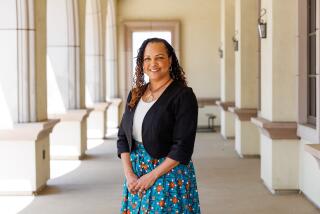Great Minds Help Develop Their Brains : Education: Renowned scientists are part of a hands-on program that whets young students’ curiosity in once-ignored subjects.
- Share via
WESTWOOD — As any parent knows, the stock answer to “What did you do at school today?” is “Nothing.”
But when that question was put to excited fifth- and six-graders at Fairburn Avenue School in Westwood last week, parents got an earful:
“I got to hold a real human brain in my hands!”
The brain--and yes, it was real--was tantalizingly hidden in a plastic bucket while renowned neuroscientist Arnold Scheibel talked with youngsters about its anatomy and function, and drew diagrams on the blackboard. Then, as tension grew and kids perched on the edge of their seats, he lifted out the two hemispheres--a wormy mass of tissue laced with veins and dripping with fixative. Some students covered their eyes, others grimaced with an “eeyuuuuh,” or pronounced the grapefruit-sized organ “gross,” “fresh,” or “cool.”
But they all raced to don plastic gloves to touch it, and peppered Scheibel with questions:
“Whose brain is it?”
“Is he dead?”
“How long does it take for a brain transplant to start working?”
“If you transplanted the brain of a mass murderer into somebody, would he start killing too?”
“Are boys’ and girls’ brains different? If a girl got a boy’s brain, would she start to like girls?”
“Are the brains of left-handed people different?”
“Where do dreams come from?”
And Scheibel, who introduced himself simply as “Arnie” although he is the director of UCLA’s Brain Research Institute and world-famous for his work on how the brain changes with age, had all the answers. Including some that emphasized how much remains to be found out--”maybe by some of you.” (The brain, by the way, came from a patient who willed his body to medical research.)
Scheibel’s four hours with Fairburn students were part of a UCLA program begun last year by UCLA chemical engineering professor Robert Hicks, whose daughter Julia is a third-grader at Fairburn.
Eight scientists from UCLA’s schools of medicine and engineering are participating in this year’s visits, aimed at giving elementary school students hands-on science experiences and whetting their appetites for the often-ignored physical sciences.
“All you see on television and the media is sports heroes and doctors, never scientists or engineers as role models,” Hicks said. “We feel children aren’t being exposed at an early enough age to available career options . . . and the best way to influence them is to share the joy and wonder and excitement of our professions.”
This kind of outreach program has become increasingly valuable as budget woes force the public school system to cut back on what were already minimal instruction programs, leaving corporations and universities to step in to fill the gap.
And they are.
This year in the UCLA-Fairburn program, for example, entomologist Walter Ebeling brought cockroaches and termites--as well as “walking sticks,” the world’s largest insects--for kindergartners, first- and second-graders to see. Hicks also explored the solar system with the students, showing slides of photographs taken by the Voyager missions to the planets. Biologist Bernard Phinney, who discovered a plant growth hormone that revolutionized farming, supervised third- and fourth-graders in experiments examining the effects of hormones on plant growth.
This week, earth and space scientist Gerhard Oertel will take youngsters to Will Rogers State Park to explore the geology of the Santa Monica Mountains. Biological chemists Dohn Glitz and Leonard Rome will discuss cells and their structure, then take the students to UCLA to see what they’ve been talking about by looking through microscopes. And computer scientist Richard Korf will show students how to program computers to create algorithms for games and other activities.
In addition to its famous experts, UCLA also sends out teams of graduate and senior undergraduate science students to schools throughout the city for enrichment programs.
Three senior chemical engineering undergraduates showed youngsters at Fairburn how two solutions combine to make strands of nylon--the stuff of their backpacks--why hydrogen peroxide on a scraped knee foams up, and how two ordinary-looking chemicals can combine to create firefly-like luminescence.
Principal Christine Curtis is enthusiastic about the program, noting that the school’s proximity to UCLA and the fact that Hicks is a parent there made the 380-student school an ideal site for such a pilot project.
“It has opened windows for children to explore,” she said. “It’s wonderful when a parent asks a child, ‘What did you do in school today?’ and he or she says, ‘I got to hold a human brain with my hands’ and is able to talk about it with understanding.”
She tells of 6-year-olds clutching the trouser legs of some of the world’s top scientific minds, the children saying, “I want to be a scientist just like you when I grow up.”
The scientists find the children’s curiosity and enthusiasm equally appealing. Hicks treasures letters from his tiny students, such as one from a first-grader that read, “Thank you for teaching us about the solar system. My favorite planet was all of them. And thank you for wasting your time just for us.”
But Hicks and his fellow volunteers know better. It wasn’t “wasted.”
*
Schools can arrange to participate in the program by calling Hicks’ office at (310) 206-6865 or Scheibel’s office at (310) 825-9578.






